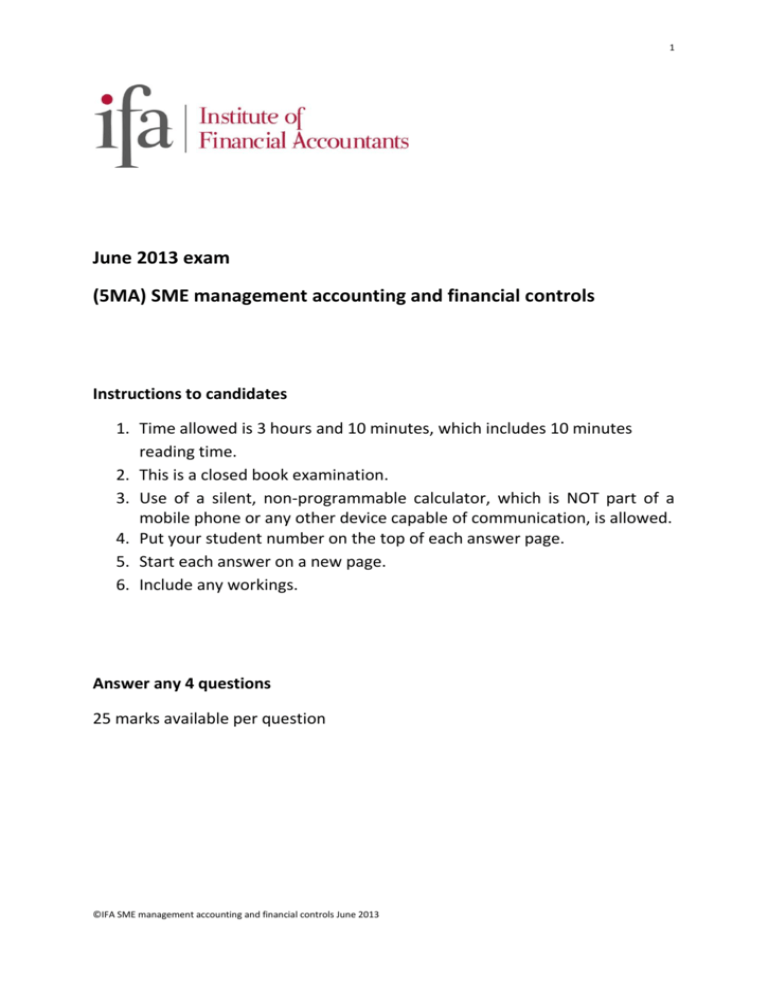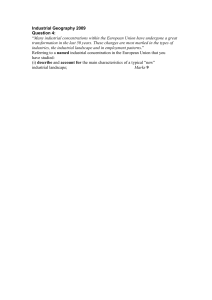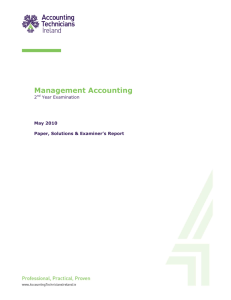June 2013 exam (5MA) SME management accounting and financial
advertisement

1 June 2013 exam (5MA) SME management accounting and financial controls Instructions to candidates 1. Time allowed is 3 hours and 10 minutes, which includes 10 minutes reading time. 2. This is a closed book examination. 3. Use of a silent, non-programmable calculator, which is NOT part of a mobile phone or any other device capable of communication, is allowed. 4. Put your student number on the top of each answer page. 5. Start each answer on a new page. 6. Include any workings. Answer any 4 questions 25 marks available per question ©IFA SME management accounting and financial controls June 2013 2 Question 1 Zeta Company is a small company which specialises in producing household equipment and kitchen utensils. The company is developing a new range of kitchen trays. The company is currently having disagreements internally with regard to the selling price for the trays. As a potential selling price is yet to be determined, costing for the new trays has not yet been prepared. The finance director thinks that the price of the trays should be set low, in order to encourage high sales volume. The production director believes that the company should invest in high quality materials and devote significant time to the design phase, so that a high selling price can be set for the trays. Market research suggests that the average price for a kitchen tray is $9 per tray. The managing director has agreed with the finance director, and the company is now seeking to set a low price. They have stated that they want to set their selling price 10% lower than the average market price. Zeta Company expects to achieve a 25% margin on all of its products. Required: (a) Explain the term ‘target costing’ and calculate the target cost to achieve the expected 25% profit margin. (6 marks) The company have now researched all appropriate costs of producing the product, but the forecasted cost is higher than the desired target cost. The profit margin cannot be compromised and the selling price cannot be increased. Zeta Company are looking to operate a scheme of value analysis and value engineering to ensure the target cost can be met without compromising the quality of the product. (b) Prepare a report to the finance director explaining the steps that Zeta Company would need to take to apply value analysis and value engineering to the new product. Your report should consider the term ‘value’ and should also focus on the different types of costs. (15 marks) (c) Describe an internal and external quality cost that Zeta Company might face with regards to this new product (4 marks) (Total 25 marks) ©IFA SME management accounting and financial controls June 2013 3 Intentionally left blank ©IFA SME management accounting and financial controls June 2013 4 Question 2 Alpha Company prepares its periodic budgets using absorption costing. The company revised the budget during the period due to an unexpected sales order. The original and revised budgets, along with the actual results have been provided. Original budget Revised budget Actual Units produced 20,000 21,000 22,200 Units sold 20,000 21,000 21,500 $ $ $ 2,000,000 2,100,000 2,257,500 - - - Material costs 160,000 168,000 188,700 Labour costs 120,000 126,000 133,200 Production overheads 55,000 57,000 58,620 Total production cost 335,000 351,000 380,520 - - 11,998 Cost of sales 335,000 351,000 368,522 Gross profit 1,665,000 1,749,000 1,888,978 Distribution costs 220,000 220,000 265,000 Administration costs 216,000 216,000 210,000 1,229,000 1,313,000 1,413,978 Sales revenue Cost of sales Opening inventory Closing inventory Non production costs Net profit ©IFA SME management accounting and financial controls June 2013 5 Notes (i) Material and labour costs are variable. (ii) Production overheads are semi-variable. (iii) Closing inventory is valued at full absorption cost per unit where appropriate. (iv) Production overheads are absorbed on a units basis. Required: (a) Prepare a flexible budget statement, with variances, applying marginal costing principles. The statement should apply the correct treatment of production and nonproduction costs, and closing inventories. (12 marks) (b) Give reasons why the flexible budget variances may have occurred. (8 marks) (c) Explain the principle of activity based budgeting and how it differs to traditional absorption costing. (5 marks) (Total 25 marks) ©IFA SME management accounting and financial controls June 2013 6 Question 3 Beta is a small company. It operates a standard cost system using absorption costing, where both variable and fixed overheads are absorbed on labour hours. The budgeted number of units was 1,800. The company produces one product; Product X. Cost cards are prepared at the start of the period. The forecasted selling price per Product X is $200 Product Quantity Cost per unit $ 6 kgs 8 per kg 48.00 Labour 1.50 hours 16 per hour 24.00 Variable overheads 1.50 hours 9 per hour 13.50 Fixed overheads 1.50 hours 10 per hour 15.00 Component A Standard cost per unit Total $ $100.50 Actual number of units produced and sold of Product X = 2,000 units The total cost of Component A was $75,000 and 9,900kg of material was purchased. The total cost of labour was $48,000 and 2,300 hours were paid. The total cost of variable overheads was $38,000 Fixed overheads were $30,000 9,000kg of Component A was used in production. There were no opening or closing inventories of finished goods. There were 300 hours of idle time. Actual sales revenue was $420,000 Required: (a) (b) Calculate the following variances for the period: (i) Material price variance. (ii) Material usage variance. (iii) Closing stock of raw materials variance. (iv) Labour rate variance. (v) Labour efficiency variance. (vi) Idle time variance. (vii) Fixed overhead expenditure variance. (viii) Sales price variance. (ix) Sales volume variance. (18 marks) Briefly explain the purpose of material mix and yield variances. You do not need to prepare any calculations. (4 marks) ©IFA SME management accounting and financial controls June 2013 7 The standard cost for labour was calculated before annual pay rises were taken into account. The average pay rise was 6%. (c) Recalculate the labour rate variance calculating how much of the variance is due to the pay increase. (3 marks) (Total 25 marks) Question 4 ©IFA SME management accounting and financial controls June 2013 8 Internal financial controls are necessary to help an organisation accomplish specific goals and objectives. They also contribute to preventing and detecting fraud and to the protection of an organisation’s physical and intangible resources. Required: Prepare a report for a managing director working for a newly established company, regarding the internal controls required within his organisation. The report should include an explanation of: (i) responses to risk: avoid, mitigate and transfer (ii) compliance risk; stating the effective internal controls required (iii) operational risk; stating the effective internal controls required (iv) management information systems (MIS) and their benefit to small and medium-sized enterprises (SMEs). (Total 25 marks) Question 5 ©IFA SME management accounting and financial controls June 2013 9 A small company, in the car sales industry, is reviewing the way in which expenses are claimed by and reimbursed to employees. Employees are provided with credit cards by the company and all business expenses are paid using the credit card. Where a credit card has reached its limit, or when an employee has left the credit card at home, employees use their personal credit or debit cards, and then make an expense claim for reimbursement. The finance director is concerned that there is a lack of internal controls over the process and that there may also be accounting and tax implications. Required: (a) Discuss the control objectives that should be achieved by the company’s expense system. Your answer should refer to the methods that can be used to verify the validity of the expense claims, authorisation and any other controls that could be implemented to improve the process. You should also state the possible fraud risk and any possible regulatory accounting or tax implications of the current system. (20 marks) (b) State the additional costs to the employer of implementing better controls and the possible costs if they choose not to improve their system. (5 marks) (Total 25 marks) ©IFA SME management accounting and financial controls June 2013










